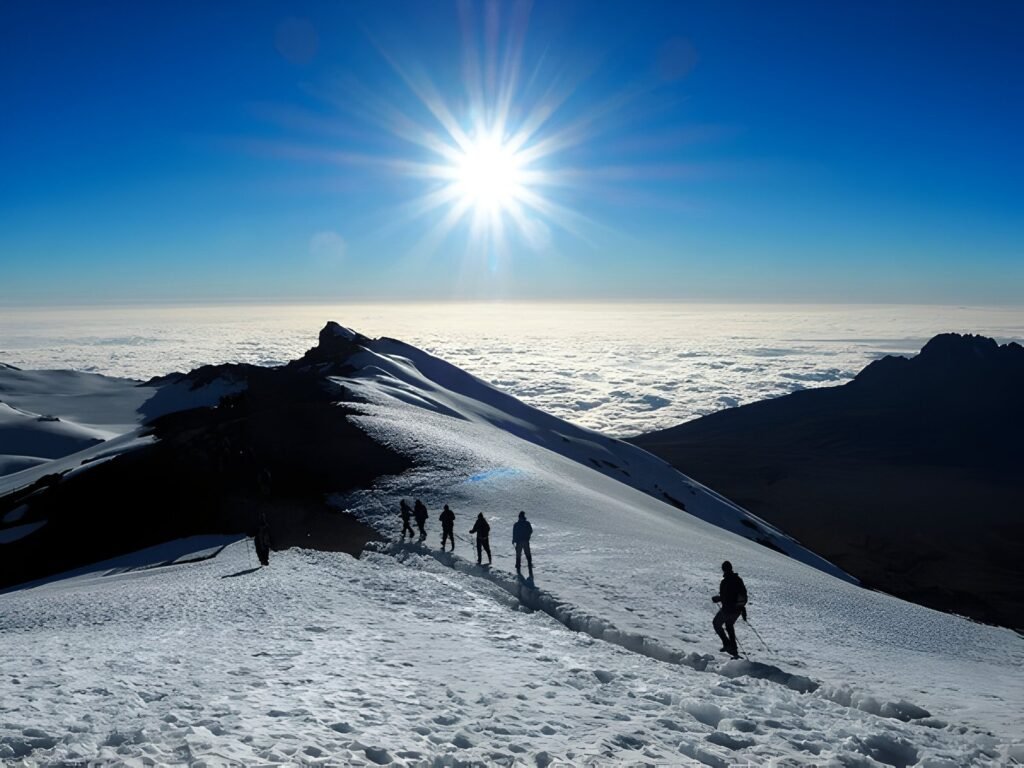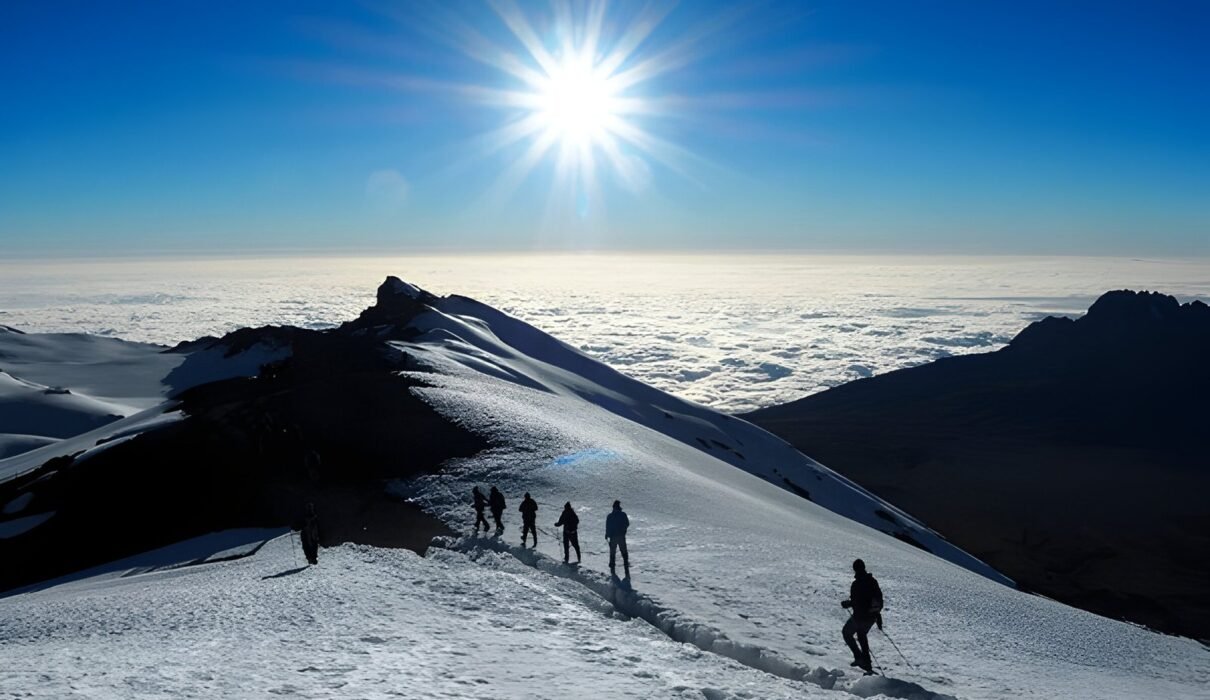Mount Kilimanjaro, Africa’s tallest peak, is famous for its snow-capped summit, despite being located near the equator. Many climbers are eager to experience the stunning snow-covered landscapes that contrast with the warm savannah below. But when exactly can you expect to see snow on the summit of Kilimanjaro? In this guide, we will explore the best times to witness snow on Uhuru Peak, how the weather changes throughout the year, and what to consider when planning your climb.

1. Snow on Kilimanjaro: An Overview
Despite being located in tropical Africa, Kilimanjaro’s summit is often covered with snow due to its extreme altitude—5,895 meters (19,341 feet) above sea level. Snow is present at the summit throughout the year, but its amount and visibility vary depending on the season.
The snow and glaciers at Kilimanjaro’s summit add a layer of beauty to the climb, making it a sought-after experience for many trekkers. However, with climate change impacting glacial retreat, it’s important to plan your visit at the right time if snow is a key part of your Kilimanjaro experience.
Learn more about Kilimanjaro’s summit with Kilimanjaro Climb Specialist
2. When Is There Snow on Kilimanjaro’s Summit?
While there is some snow year-round at the summit of Mount Kilimanjaro, certain seasons provide a better chance of seeing fresh, deep snow:
1. Rainy Season (March to May and November to December)
- March to May: This is the long rainy season in Tanzania, and while climbing during this time can be more challenging, the summit often sees fresh snowfall during this period. The snow can be thick and provide stunning views, but trails can be slippery, and the lower slopes may be muddy.
- November to December: Known as the short rainy season, this period also brings fresh snow to Kilimanjaro’s summit. Climbers during this time should be prepared for wet conditions on the lower slopes and colder weather near the top.
Discover more about climbing Kilimanjaro during the rainy season
2. Dry Season (June to October and January to February)
While the dry season offers more stable weather conditions and clearer skies, snow at the summit is still visible but not as abundant. Climbers can still enjoy the sight of Kilimanjaro’s glaciers, but snowfall may be lighter or limited to patches.
- June to October: This is the best time to climb in terms of weather and visibility, but snow may be less prominent during these months. However, the climb will be more comfortable, and the summit remains capped with snow.
- January to February: These months fall between the two rainy seasons and offer good climbing conditions with a chance of light snow at the summit.
Plan your Kilimanjaro trek with the best conditions at Eddy Tours Safaris
3. Kilimanjaro’s Glaciers and Snowfields
The glaciers of Mount Kilimanjaro, including the famous Furtwängler Glacier, are some of the most striking features at the summit. Although these glaciers have been receding due to climate change, they still contribute to the snow that blankets the summit.
- Glacier Size: Kilimanjaro’s glaciers are shrinking rapidly, and experts predict that they may disappear entirely within a few decades. If witnessing these glaciers is important to you, plan your climb soon to experience them before they retreat further.
- Snow Coverage: The snow on Kilimanjaro’s summit can cover the paths, making the final ascent to Uhuru Peak challenging, but rewarding. Trekkers are advised to be prepared for snow-covered terrain, especially during the wet seasons.
Learn more about Kilimanjaro’s glaciers and how climate change is affecting them
4. Best Time to Climb for Snow-Covered Views
If you want to experience the summit of Kilimanjaro in its snowiest state, the rainy seasons from March to May and November to December offer the best chances. However, if you prefer more moderate conditions but still want to see snow, January to February and June to October also provide great opportunities for snow views, though with less fresh snow.
Advantages of Climbing in the Rainy Season
- Less Crowded: Since fewer people climb during the rainy season, the trails are less crowded, providing a more private experience.
- Stunning Snowy Scenery: The summit and higher camps will be blanketed in snow, creating a magical and pristine landscape.
Challenges:
- Wet and Muddy Conditions: The lower slopes can be wet, making trekking more difficult.
- Cold Temperatures: The higher altitudes will be colder, especially with the snow, so proper gear is essential.
Find out how to prepare for trekking Kilimanjaro in cold conditions
5. What to Pack for a Snowy Kilimanjaro Climb
If you’re climbing during a time when snow is more likely at the summit, it’s important to pack properly to handle both the cold and the snow.
Essential Items:
- Insulated Jackets: Layered clothing is essential, including a warm down jacket for summit day.
- Waterproof Gear: Waterproof pants, jackets, and gaiters are a must to protect against snow and rain.
- Thermal Gloves and Socks: Keeping your hands and feet warm is crucial, so pack thermal or wool gloves and socks.
- Trekking Poles: Snow can make the trail slippery, especially during the descent, so trekking poles help with stability.
Learn more about essential gear for climbing Kilimanjaro
6. How Snow Affects the Climb
Climbing Kilimanjaro when there is snow on the summit adds both beauty and challenges to the trek. Snow-covered trails near the summit can make the final ascent to Uhuru Peak more difficult, requiring extra caution.
- Slippery Conditions: Snow can make the rocks and paths at high altitudes slick, so climbers need to be careful during the final push to the summit.
- Colder Temperatures: The snow brings colder temperatures, especially during the night at high altitudes. Proper layering and high-quality sleeping bags are essential.
Despite the challenges, climbing Kilimanjaro in the snow offers a unique and breathtaking experience, with stunning landscapes that make the trek even more rewarding.
Prepare for snow conditions on Kilimanjaro with these tips
FAQs About Snow on Kilimanjaro
1. Is there snow on Kilimanjaro year-round?
Yes, there is snow on Kilimanjaro year-round, but the amount of snow varies depending on the season. The summit has more snow during the rainy seasons (March to May and November to December).
2. Do I need special equipment to climb Kilimanjaro in the snow?
No, you don’t need technical equipment like crampons or ice axes. However, warm, layered clothing and waterproof gear are essential for snow and cold temperatures.
3. Which Kilimanjaro route is best for seeing snow?
All routes lead to the summit where snow is found, but routes like Machame and Lemosho offer more scenic views of Kilimanjaro’s glaciers and snowfields.
Choose the best route for your Kilimanjaro climb with Kilimanjaro Climb Specialist
Start Planning Your Kilimanjaro Climb Today
Whether you’re hoping to witness Kilimanjaro’s glaciers before they disappear or simply want to experience the thrill of standing on a snow-covered summit in Africa, timing your climb is key. With proper planning, the right gear, and knowledge of the best seasons, you can enjoy a spectacular Kilimanjaro trek with stunning snowy views.
Start planning your Kilimanjaro climb with Kilimanjaro Climb Specialist
Book your guided Kilimanjaro trek with Eddy Tours Safaris

